Diving at Banco Chinchorro
About 35kms off the coast of Mahahual lies a mysterious yet wonderful coral atoll, full name Reserva de la Biósfera Banco Chinchorro. This national park, rich in history, is also a graveyard for all sorts of sunken ships. A natural protected area since 1996, it conserves its natural beauty, holding secret to a collection of wrecks scattered alongside the exterior reef.
What makes Banco Chinchorro so special with us
UNESCO Biosphere Reserve
Pristine marine ecosystem protected by international conservation status
Certified by National Institute Anthropology and History
Historic shipwrecks including the famous 40 Cannons site
Diverse Marine Life
Sharks, rays, turtles, and hundreds of tropical fish species
Crystal Clear Waters
Great visibility all year-round
Over 30 Dive Sites
Access to dozens of mapped dive sites across the atoll
Exclusive Access
Dozens of exclusive dive sites available for our clients
Explore Banco Chinchorro
Atoll map and diving video
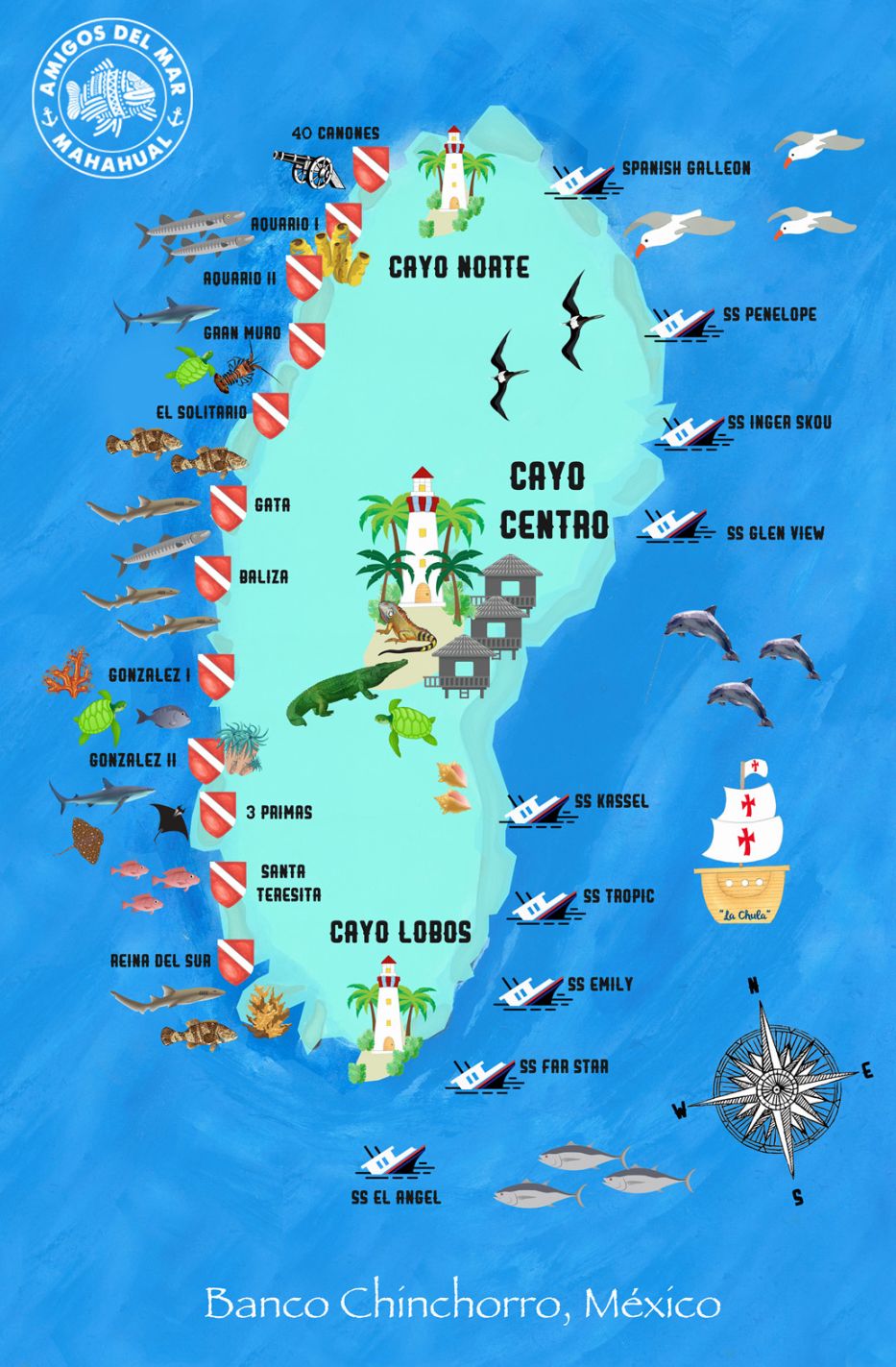
Dive Sites
Explore our most popular diving locations at Banco Chinchorro
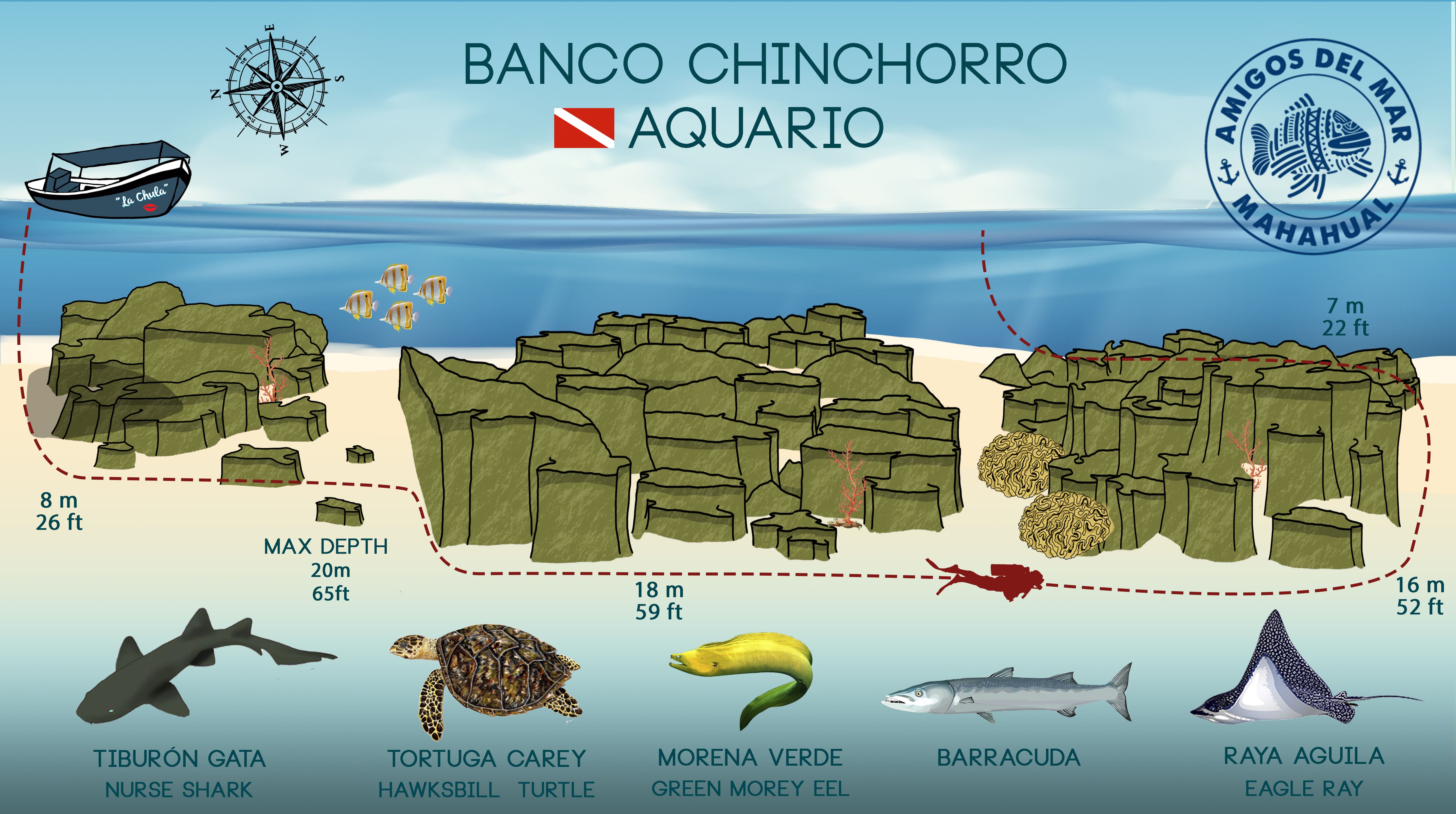
Aquario 1 & 2
These are some of the prettiest dive sites in all of Banco Chinchorro. As you descend you'll wonder which way to look, surrounded by a coral wonderland. More soft corals are found here than anywhere else on the Caribbean coastline and there is also an abundance of sea fans, elk horn, fire and brain coral. And it's not just the coral that will impress; there are fish literally everywhere! From schools of blue tangs and snappers, big lobsters and barracudas prowling, to huge green moray eels protruding from their caves and tiny beautiful flamingo tongues clinging to fans. Nurse sharks and eagle rays often hover over the sandy bottom and lucky divers might even spot some dolphins passing by.
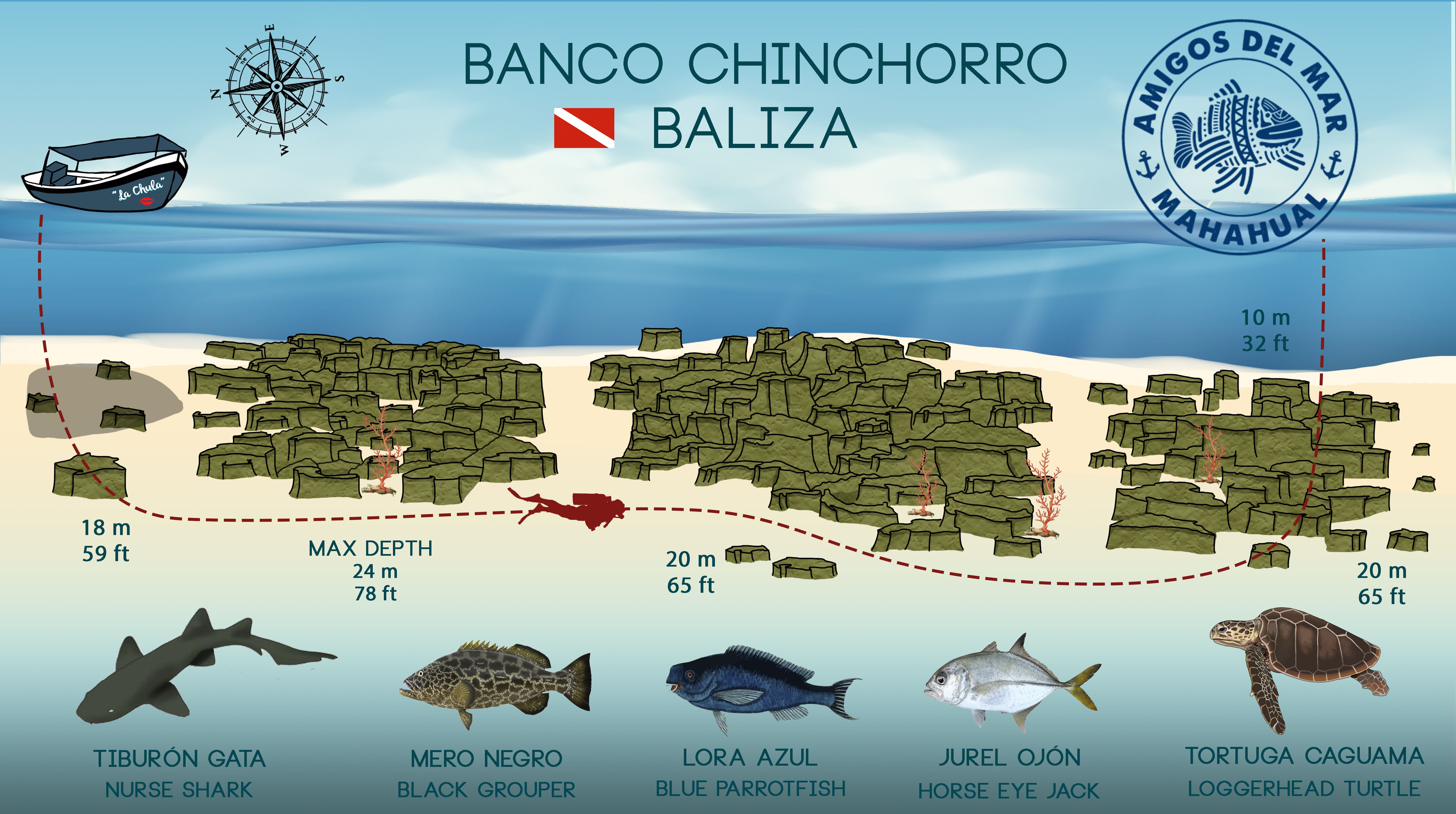
Baliza
This is a particularly special dive for those who love sharks. Usually two or three nurse sharks approach divers on their descent and will stay with the group for the duration of the dive; a fantastic opportunity to get a really good look at these fascinating creatures. The dive starts in a sandy area heading south over the reef, which is split into three different sections. The maximum depth is about 20 metres but it's not even necessary to go this deep as both the shallow and deep sections are equally impressive with huge yellow sponges and schools of jacks and sardines. You'll also likely see groupers, blue parrotfish, and turtles.

Gata
Gata refers to the Spanish name for nurse sharks, which are the highlight of this dive site. Unlike in all other places, the nurse sharks are highly active and follow the divers around until the end of dive, approaching the group curiously and making gentle turns so you can experience all their grace, strength and beauty in a spectacular way. The site is divided into three different reef sections, crossing over two sandy slopes to navigate between them. The corals are really healthy and among the nurse sharks, you can expect to encounter reef fish in all different colours, shapes, and sizes, as well as black groupers, hawksbill and green turtles, moray eels, giant lobsters. A huge school of sardines hang out on the third reef which is quite a spectacle.
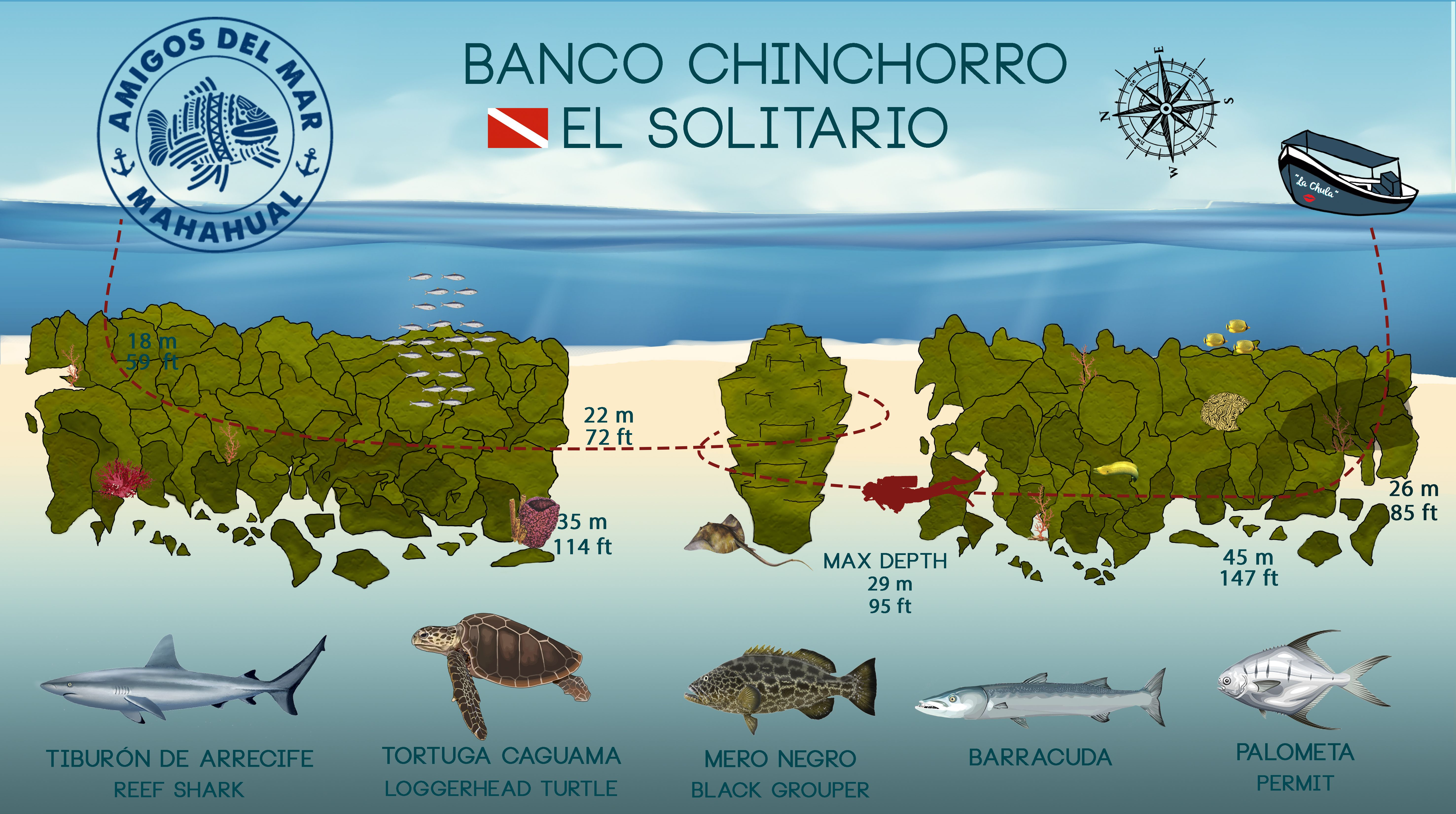
El Solitario
The name of this dive site means "lonesome" in Spanish which is fitting as the dive includes traversing between two different reefs via a solitary giant coral rock located between the two. For divers who like to use their compasses this is a great opportunity to practise navigation skills. The dive starts at a depth of between 20 and 24 metres at the first reef, which boasts incredible corals and marine life. When reaching the sand, by swimming north-west out into the depths over the sand, divers will soon notice a huge shadow growing bigger. Finally, a huge rock appears, starting at 15 metres and dropping down to the sand at 35 metres, which is a favourite resting place for rays and nurse sharks. After circling the pinnacle divers head North-East to reach the second wall.
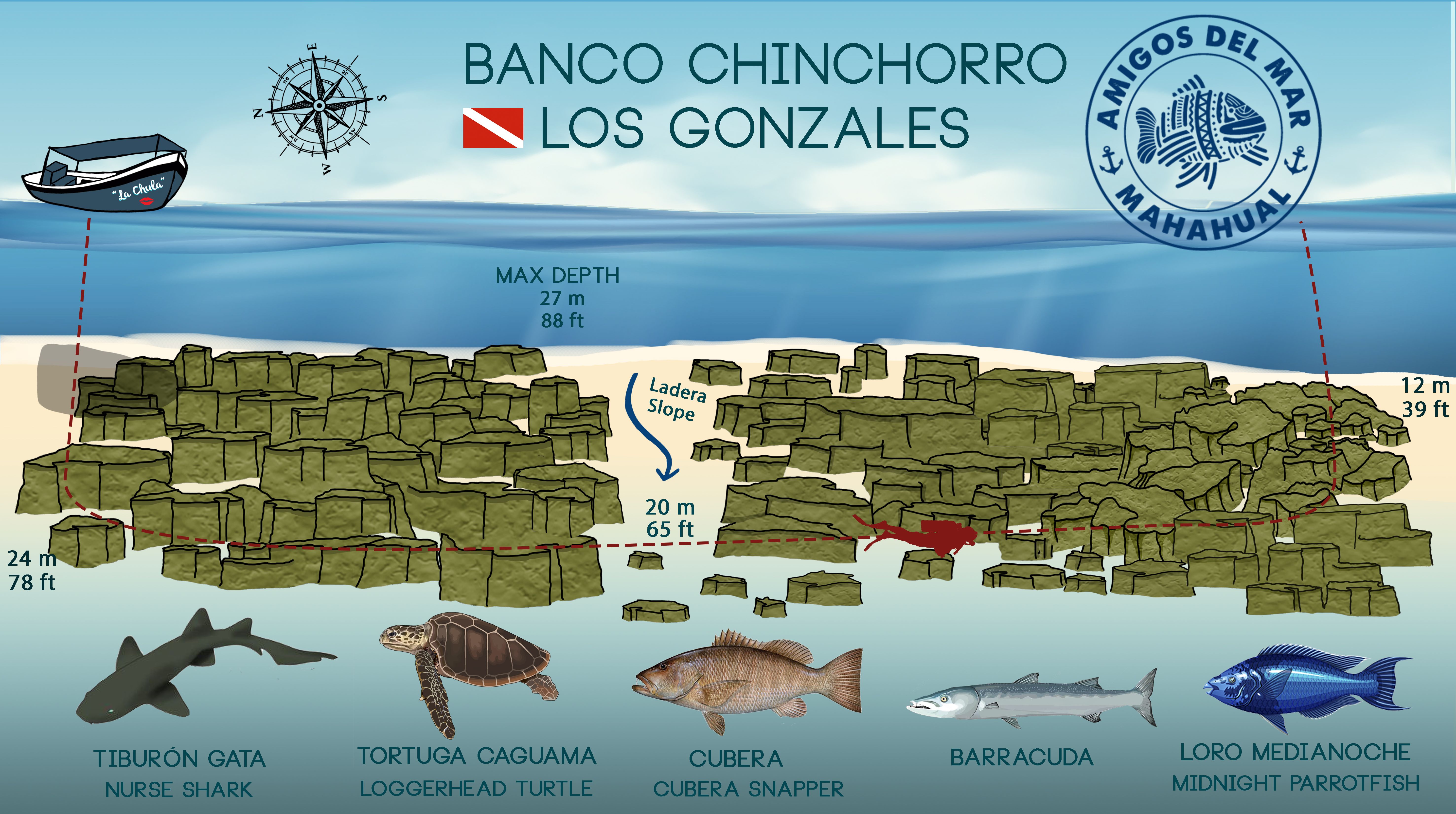
Gonzales 1 & 2
Right in front of Cayo Centro, the main landmass of Banco Chinchorro, is Punta Gonzalez. This is a hugely diverse dive with depths ranging between 8 and 35 metres. Sticking to the main site divers will usually dive at between 12 and 24 meters making it perfect for beginners. However, in the summer months when the current isn't as strong, advanced divers can enjoy the chance to go to the deeper parts where a huge underwater pinnacle is visible rising from about 50 up to 30 metres deep. The reef topography varies greatly, with some of the most beautiful coral formations Chinchorro has to offer, made even more spectacular by the visibility of 20 metres plus. Divers will swim over sandy areas, through canyons, past pinnacles and along cracks in the reef.

Gran Muro
For those who love the thrill of an amazing wall dive, Gran Mure is not to be missed. The upper reef starts at just 15 metres depth and slopes down to where the wall begins at 20 meters, dropping to a breath-taking 60 metres in some parts. At Gran Mure everything is a bit bigger than anywhere else in Chinchorro. You'll swim past enormous barrel sponges, some of which are up to three metres tall; as well as beautiful giant yellow tube sponges, which grow to be thousands of years old. Another highlight are the huge schools of bonnetmouth and boga fish which are truly incredible to see - thousands of small fish moving together frantically in what is known as a bait ball. This can attract all kinds of predators: groupers, barracuda, permit, trevally and horse-eye jacks.
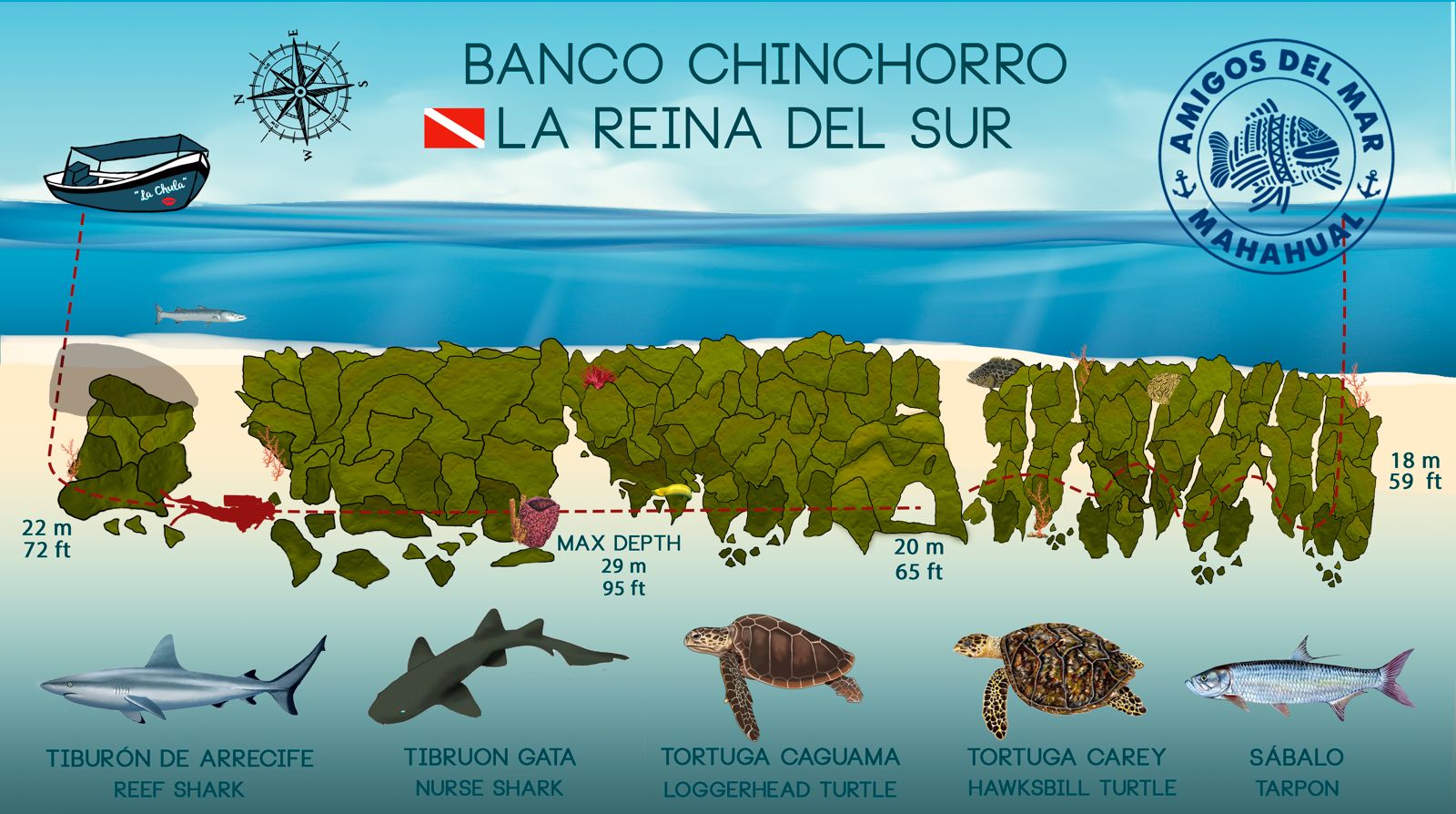
Reina del Sur
Translated to English, this site means Queen of the South and divers will understand why as they drift through more than a kilometre of colourful coral gardens. The average depth of about 15 metres means it's quite unusual to find huge barrel sponges and black coral at these depths - an indicator that this is a very healthy reef system. There's also an incredible amount of marine life to enjoy including hawksbill, green, and loggerhead turtles, which can be seen darting in and out of the canyons and swimming happily over the reef. Schools of sardines are amazing to watch as they dance and shimmer in the light, always on the lookout for predators such as jacks, tarpons and even African pompano. As the dive continues north, divers will notice pinnacles approaching and also that the reef drops down deeper to more than 30 metres.
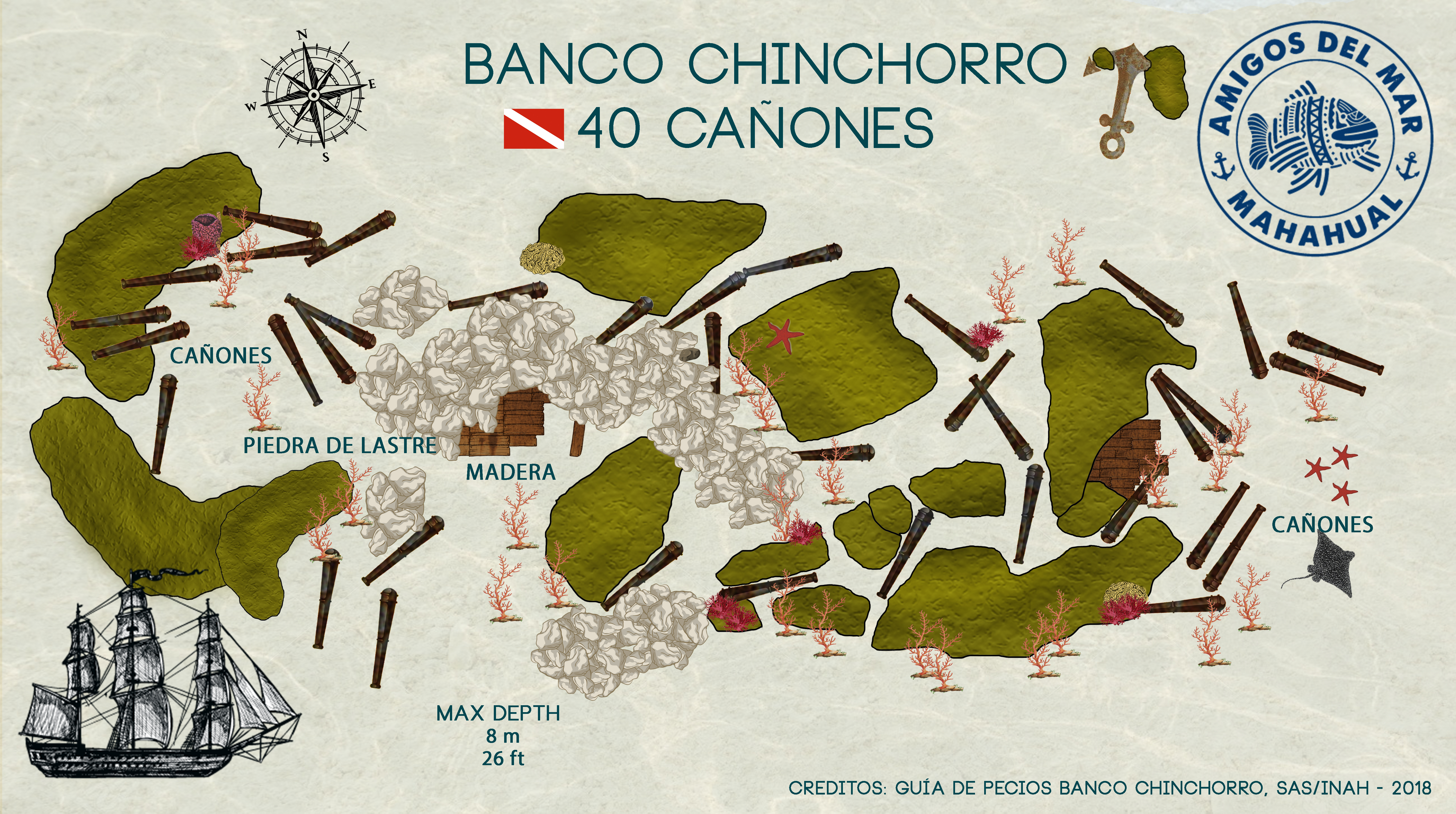
SS 40 Cannons
This shipwreck was once a Spanish galleon and part of an armada of 17 boats in total. This particular ship was delayed leaving port in Cartagena, Colombia on its voyage towards Havana, Cuba. Trying to catch up with the rest of the armada heading around the Yucatán peninsular at night, the navigator and look-out sailor failed to see the atoll in the pitch-black conditions. Their fate was decided as they ran aground in Chinchorro in 1648. This is a superb dive site which will take you back almost 500 years in time. 36 cannons are scattered around an area of 30 by ten metres and a giant cast-iron double-fluke anchor lies some 40 metres west of the cannons. Ballast stones and even small wooden parts are still visible and much of it is encrusted with layers of coral. This shipwreck is part of the underwater museum at Banco Chinchorro.
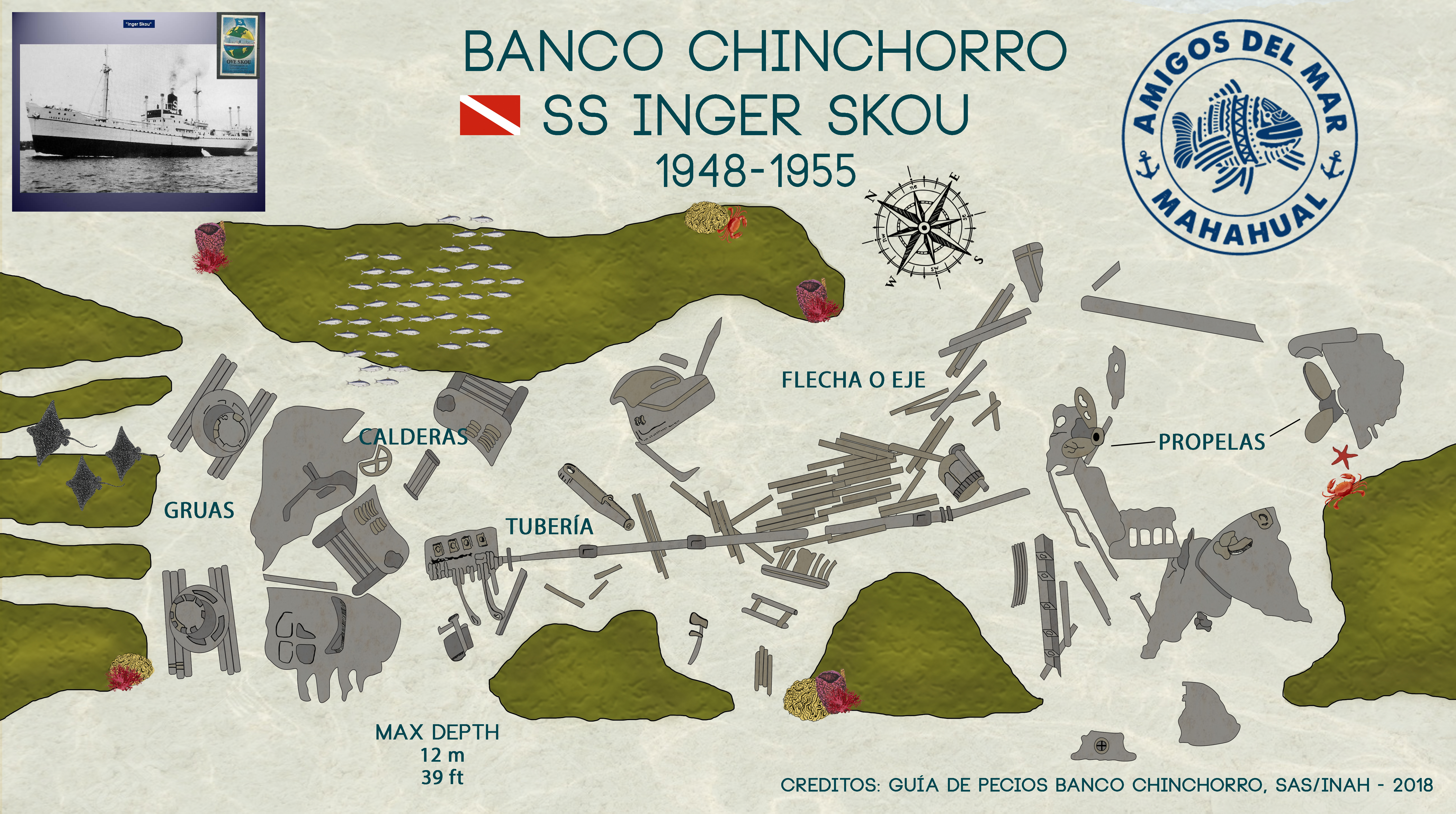
SS Inger Skou
Located north-east of Cayo Centro, this shipwreck was once a Danish steamboat from the 19th century. It was a huge vessel and was transporting heavy machinery and metal when it ran aground in Banco Chinchorro in 1955. It is known that on her last journey she was on route from north to south, but we don't know why she ended up sunken at Banco Chinchorro. It's easily the best shipwreck to explore in the area due to the size and the number of artifacts, as well as the beauty of the surrounding reef. Diving this site, you'll find yourself surrounded by majestic industrial underwater scenery inhabited by snappers, parrotfish, and hogfish. We usually start the dive in a deeper section, hovering in between canyons with huge sea fans and gorgonians being swept from side to side with the swell.
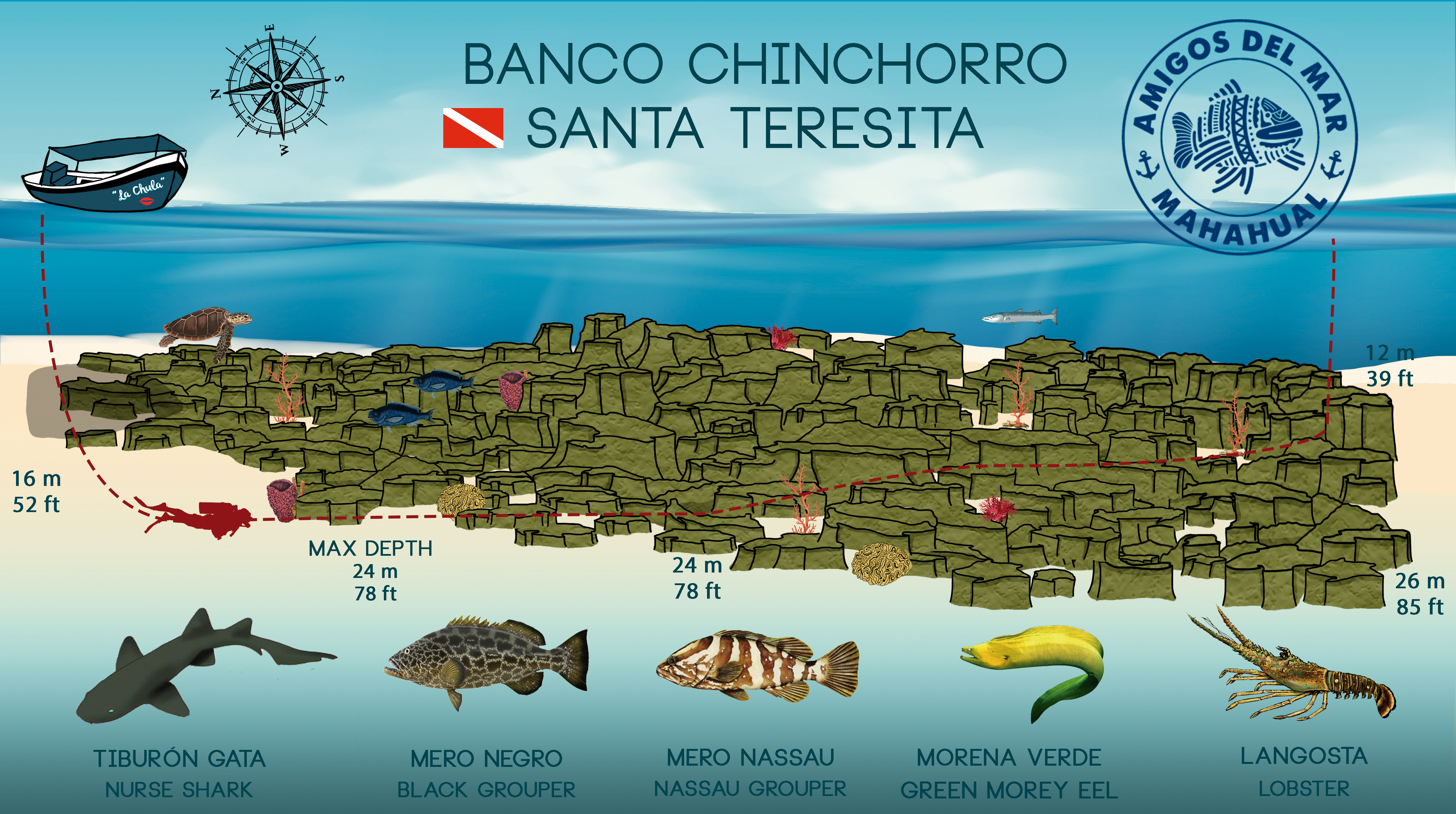
Teresitas
This is a beautiful wall dive with a maximum depth of about 25 metres, however the dive starts shallow giving divers a chance to get adjusted and enjoy watching the huge conches in the sand, noticing their many trails. About half way through the dive you'll reach the deepest part of the wall where smaller creatures are often found, like crabs and shrimps, as well as groupers and parrot fish, swimming among beautiful coral formations. The group will shallow up towards the end of the dive to enjoy swimming on top of the reef, swarming with schools of both juvenile and adult reef fish. There's also a good chance of seeing nurse sharks, turtles and barracudas.

Coral Negro
Coral Negro is one of the most spectacular wall dives in Banco Chinchorro. The site's topography has it all — from a vibrant coral garden that begins around 50 feet to a dramatic wall that drops to depths of roughly 150 feet. Since its discovery, Coral Negro has remained one of our all-time favorite sites at the atoll. Every dive here offers something unforgettable. We usually begin at the northern tip of the reef and drift through a maze of coral formations teeming with life. Resident reef sharks are often seen cruising along the blue edge of the wall, and they're frequently curious enough to approach divers for a closer look. You might also encounter nurse sharks, graceful giant eagle rays, large groupers, and shimmering schools of baitfish. Loggerhead and hawksbill turtles are commonly spotted resting or hiding among the corals in the shallower sections.
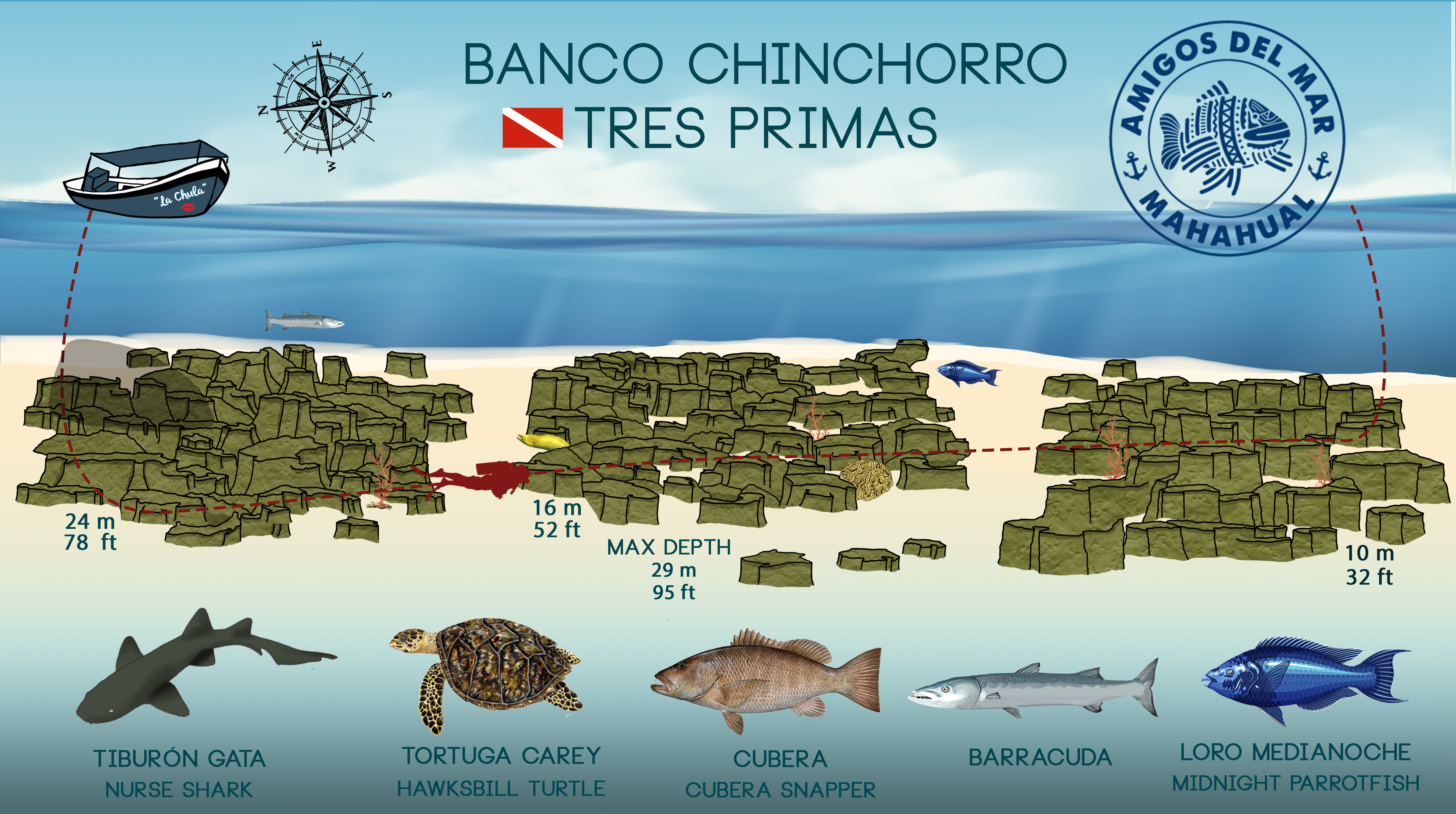
3 Primas
Located in the southern part of the atoll, this reef section is named after three identical reef formations separated by sandy areas. The beautiful coral structures make it an excellent shallow dive, ranging from 40 to 50 feet (10 to 13 meters). The area is teeming with marine life, including nurse sharks, hawksbill turtles, numerous eels hiding in crevices, as well as plenty of lobsters and rays that call this reef home. It is an easy dive with usually no current, making it ideal for beginners or as a relaxing final dive of the day.
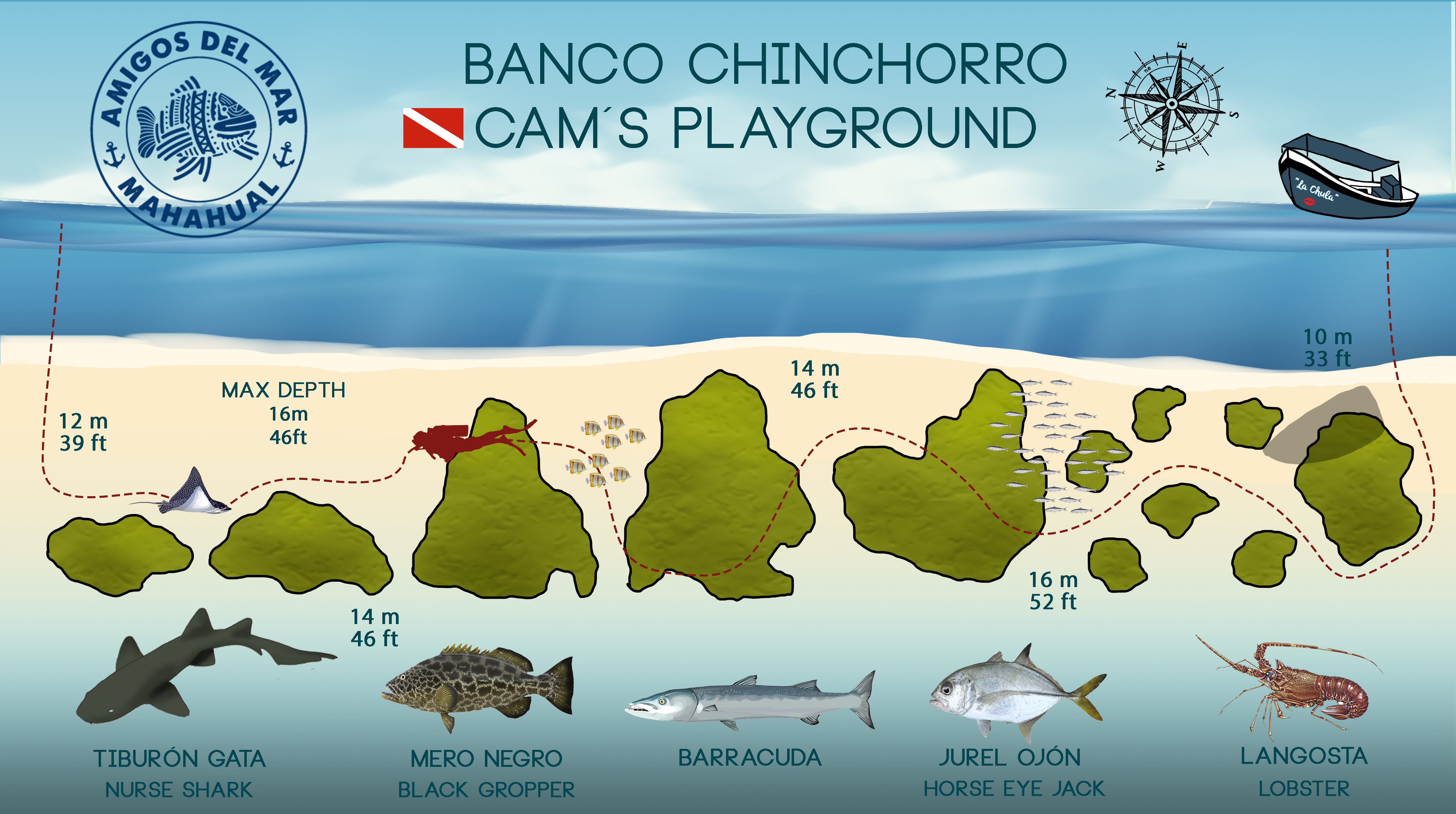
Cameron's Playground
This dive site was named after our good friend Cameron Donaldson, in honor of the day we used his DPVs to explore some of the deeper drop-off reefs in Banco Chinchorro with our buddy Robert Stansfield. The visibility was crystal clear that day—one of those perfect Caribbean dives. While cruising along at around 100 feet, we spotted a stunning reef formation rising from below. We decided to turn toward it and finish our dive exploring the shallower section instead. What we discovered was a smaller reef barrier teeming with marine life and offering superb visibility almost all year long. The site is now known for its nurse sharks, Caribbean reef sharks, large groupers, and vast schools of colorful reef fish. We usually start the dive from south to north, gliding slowly through the vibrant coral gardens. Because the reef sections are compact and full of life, a relaxed pace lets you take in every detail of the brilliant coral formations and the bustling aquatic life that surrounds you.
Trip Details
What's Included
- ✓All diving equipment
- ✓3 tanks in different dive sites
- ✓Lunch, snacks and beverages
- ✓Professional dive guides
- ✓Round-trip boat transportation
NOT Included
- ✗Marine Park entrance fees
What to Bring
- •Swimwear and a small towel
- •Reef friendly sunscreen
- •Dive certification card
- •Logbook
Requirements
- !Open Water certified
- !Two logged dives in past 18 months
- !Good physical condition
All day trip (7-8 hours)
Departure: 8:30 AM • Return approx: 3:30 PM
More Dive Sites Available
Amigos del Mar can also arrange dives on request to these additional sites:
Contact us for more information about these special sites
Our Boat: La Chula
Vessel Specifications
Type
33-foot fully customized Panga boat
Comfort
Canopy covering all seating area
Engines
2x 140hp Suzuki 4-Stroke Twin Engines
Lean Burn Technology
Capacity & Equipment
Capacity
Maximum 14 divers plus crew
Tank Storage
30 racks for dive tanks
+ 2 additional tanks at rear
Safety
Fully equipped with safety gear
Experience comfort and safety on our professionally maintained vessel, designed specifically for the unique conditions of Banco Chinchorro.